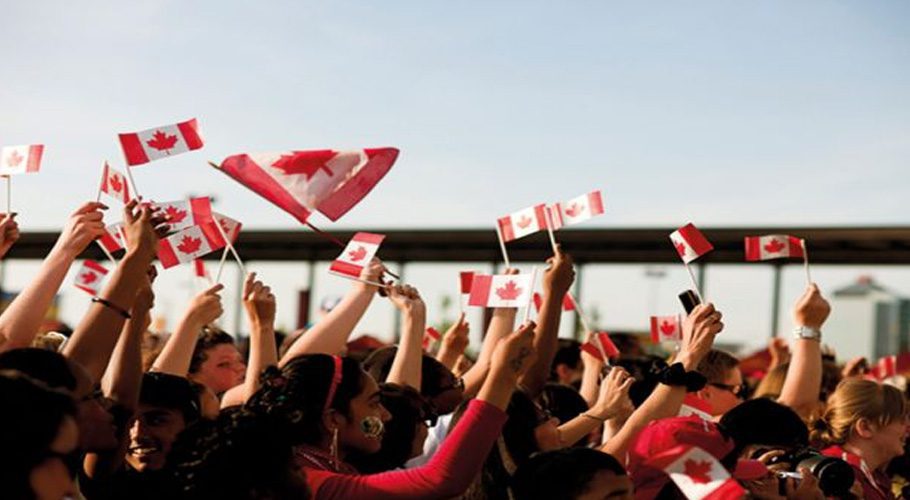Canada needs over 400,000 employees in various sectors under its new immigration policy. Canada has an immigration program with 13 pathways. In the 2023 immigration level plan, there is room for more than 76,000 newcomers in the refugee class in Canada.
In 2023, Canada aims to welcome a record 465,000 new permanent residents as it seeks to address labor market shortages. The time to move to Canada has never been better, as Canada intends to break previous records after establishing new annual permanent resident records in 2021 and 2022.
Here are details of 13 pathways through which aspiring individuals can migrate to Canada in 2023:
- Express Entry
Express Entry is the most important method of moving to Canada in 2023.
The Points-based Selection System is used to control applications for important federal programs. This year, a special lottery related to professions will also be introduced through Express Entry.
Canada introduced changes to the law last year to address the shortage of specific economic workers, making this lottery draw possible. This draw is set to start soon.
According to the latest plans for immigration levels, Canada aims to welcome around 83,000 Federal High Skilled Workers in 2023, which will increase to 109,000 in 2024 and 114,000 in 2025.
Following the start of the New National Occupational Classification (NOC 2021), 16 new occupations are eligible for Express Entry through the Federal Skilled Worker Program. From truck drivers to nurses and teaching assistants to payroll administrators, many new occupations are eligible for entry under Canada’s large-scale immigration stream.
2. Provincial Nominee Programs
In 2023, Express Entry is a major combined force with Canada’s Provincial Nominee Programs. Canada intends to welcome over 105,000 newcomers through provincial (and two territorial) immigration programs.
From British Columbia in the west to Alberta, Saskatchewan, and Manitoba in the Prairie provinces, extending to Ontario and the Atlantic provinces of Nova Scotia, New Brunswick, Newfoundland and Labrador, and Prince Edward Island, there are thousands of spots available for Canada’s immigration in 2023. Some portions of the Provincial Nominee Programs also contribute to Express Entry, meaning that each of the above-mentioned provincial programs has specific streams for selection under the federal system of Express Entry. Provinces are ready to select specific nominees according to their economic needs.
3. Quebec
Quebec’s strong provincial government is emphasizing the need to ensure the reliability of the number of all newcomers welcomed to the province.
François Legault, leader of the Coalition Avenir Quebec, believes that preserving Quebec’s French culture is central and is focused on limiting newcomers to approximately 50,000 overall, with approximately 33,000 through economic programs.
4. Pilot Programs
Canada also operates several pilot programs targeting specific economic regions or areas facing labor shortages. Covering the four provinces bordering the Atlantic Ocean — Nova Scotia, New Brunswick, Newfoundland and Labrador, and Prince Edward Island — AIP has set aside 8,500 spots for skilled workers and international graduate nominees in 2023.
An additional 8,500 newcomers will be welcomed through three other streams, including the Agri-Food Pilot, Rural and Northern Immigration Pilot, and the Economic Mobility Pathway Project. All these programs are operated through AIP, which means they are not directly applicable. An AIP indicates a need, seeks to fulfill that need by finding a nominee, and utilizes the program to bring that candidate to Canada.
5. Start-Up Visa
Canada’s Start-Up Visa has become an important route for individuals with entrepreneurial minds interested in Canadian immigration. To qualify, aspiring candidates with qualifying businesses or entrepreneurial ideas need the support of a designated person from the Venture Capital Group, Angel Investor Group, or Business Incubator Program. Additionally, they need the required settlement funds and language proficiency.
Before becoming eligible for permanent residence, candidates can come to Canada on a work permit while establishing their business. To be eligible, applicants must be actively involved in the management of a business within Canada.
In 2023, Canada intends to welcome 3,500 newcomers through business programs, which will increase to 6,000 by 2025. A significant number of these will come through the Start-Up Visa.
6. Provincial Business Programs
Many provinces in Canada operate their business programs, which fall under their respective provincial nominee programs. Each of these programs has specific requirements that are relevant to the province or region they serve.
7. Self-Employed Program
Both the federal government and Quebec operate self-employed programs.
The Federal Self-Employed Class is designed for applicants who have the intention and ability to create their own employment by making a significant contribution to cultural, artistic, or athletic life in Canada and have relevant experience in self-employment.
In Quebec, self-employed applicants are generally differentiated from skilled workers as they establish their employment by practicing a trade or engaging in business.
8. Spouses and Children
Canada includes spouses, partners, and children in its immigration levels plan, with a goal to welcome around 78,000 newcomers in 2023, the majority of which are part of the strong family class of 106,000.
Spouses and partners are allowed to apply for sponsorship or partner outside or inside Canada. They are eligible for open work permits and can await action on their applications.
Sponsored dependent children are usually under 22 and don’t have a spouse or partner. To be eligible as dependents over 22, they must be financially dependent due to mental or physical conditions or have relied on their parents for financial support before the age of 22.
9. Parents and Grandparents
Canada’s Parents and Grandparents program operates on a lottery system where sponsors express interest and are randomly selected, then invitations to apply are issued.
Canada aims to welcome around 28,500 newcomers through this stream in 2023.
10. Study Permit and Post-Graduation Work Permit
Canada offers a pathway for international students to obtain permanent residency, expecting that by 2023, 750,000 individuals will have studied in Canada, potentially the largest source of temporary residents, with only a fraction becoming permanent residents.
Many immigration consultants, colleges, and universities promote that international students can study and transition to permanent residency in Canada.
11. Temporary Workers
Canada’s work permit holders, including Temporary Foreign Workers, come to Canada through various channels.
LMIA-exempt work permits allow Canadian employers to hire foreign workers without the need for an LMIA. This includes intra-company transferees, individuals entering Canada as part of trade agreements, and those who are eligible for open work permits.
TFWP has four streams: High-Skilled Workers, Low-Skilled Workers, Seasonal Agricultural Workers Program, and Live-In Caregiver Program.
12. Buy a Business and Move to Canada
Options are available for candidates who wish to buy a business and move to Canada. OIENP Entrepreneur Success Integration Auto-Entry is a two-year pilot project aiming to welcome 100 newcomers from outside Toronto and raise a $20 million investment.
13. Refugee Immigration
Canada prioritizes welcoming asylum seekers as part of its humanitarian efforts worldwide.
Due to Canada’s open-hearted approach, Syrians, Afghans, and Ukrainians have benefited. The federal government recently invested $6.2 million in a new economic pathway initiative to bring skilled refugees to Canada.
In the 2023 Immigration Levels Plan, the refugee class has space for over 76,000 newcomers to Canada.



































